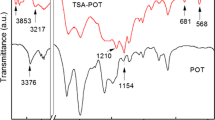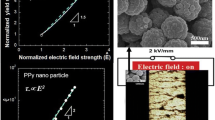Abstract
The electrorheological (ER) response and dielectric properties of the polypyrrole (PPy) dispersions in mineral oil were investigated. Various PPy particles were synthesized controlling the amount of oxidant and surfactant to investigate the effect of these variables on the ER response. The ER response increases with the oxidant and surfactant amount, passes through a maximum, and then decreases with the oxidant and surfactant amount. However, the decrease in the ER response at large surfactant amounts is not so significant compared to that at large oxidant amounts. The increase in the ER response with the oxidant and surfactant amount arises from the enhanced particle polarization originated from the increased PPy conductivity. The decrease in the ER response at large oxidant amounts seems to arise from the increased conduction between the PPy particles, while that at large surfactant amounts arises from the decreased particle polarization.
Similar content being viewed by others
References
W. M. Winslow, J. Appl. Phys. 20 (1949) 1137.
Y. F. Deinega and G. V. Vinogradov, Rheol. Acta. 23 (1984) 636.
Z. P. Shulman, R. G. Gorodkin and E. V. Korobko, J. Non-Newt. Fluid Mech. 8 (1981) 29.
K. D. Weiss and J. D. Carlson, J. Intell. Syst. Struct. 4 (1992) 13.
J. E. Stangroom, J. Stat. Phys. 64 (1991) 1059.
D. L. Klass and T. W. Martinek, J. Appl. Phys. 38 (1967) 75.
Y. D. Kim and D. J. Klingenberg, J. Coll. Interface Sci. 168 (1996) 230.
Y. D. Kim, ibid. 236 (2001) p225.
F. Ikazaki, A. Kawai, K. Uchida, T. Kawakami, K. Edamura, K. Sakurai, H. Anzai and Y. Asako, J. Phys. D: Appl. Phys. 31 (1998) 336.
Y. Otsubo and K. Edamura, J. Coll. Interface Sci. 168 (1994) 230.
C. J. Gow and C. F. Zukoski, ibid. 136 (1990) 175.
M. S. Cho, H. J. Choi and K. To, Macromol. Rapid Commun. 19 (1998) 271.
J. W. Goodwin, G. M. Markham and B. Vincent, J. Phys. Chem. B 101 (1997) 1961.
H. Block, J. P. Kelly, A. Qin and T. Watson, Langmuir 6 (1990) 6.
Y. Kudoh, Synth. Met. 79 (1996) 17.
R. B. Bjorklund and B. Liedberg, J. Chem. Soc. Chem. Commun. (1986) 1293.
M. Parthasarathy and D. J. Klingenberg, Mater. Sci. Eng. Rep. R 17 (1996) 57.
H. Block and J. P. Kelly, J. Phys D: Appl. Phys. 21 (1988) 1661.
J. N. Foulc, P. Atten and N. Felici, J. Electrostat. 33 (1994) 103.
Author information
Authors and Affiliations
Corresponding author
Rights and permissions
About this article
Cite this article
Kim, Y.D., Song, I.C. Electrorheological and dielectric properties of polypyrrole dispersions. Journal of Materials Science 37, 5051–5055 (2002). https://doi.org/10.1023/A:1021091700296
Issue Date:
DOI: https://doi.org/10.1023/A:1021091700296




